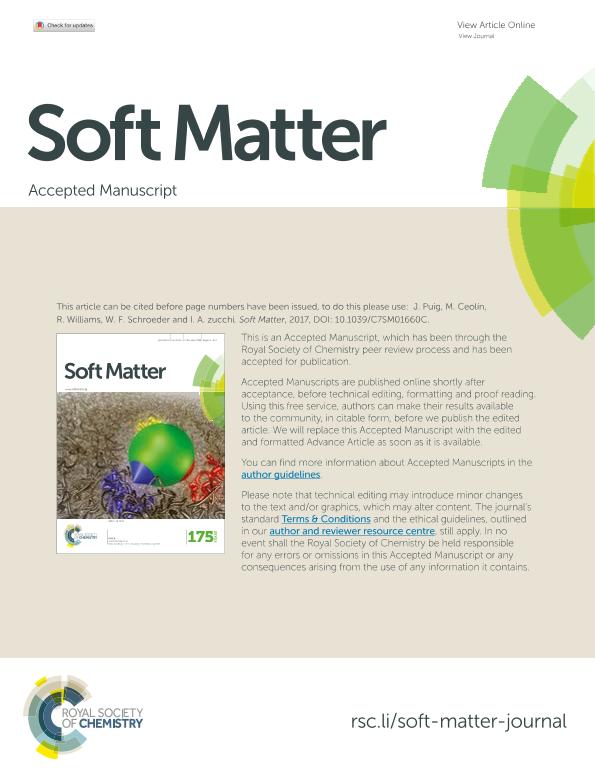Mostrar el registro sencillo del ítem
dc.contributor.author
Puig, Julieta

dc.contributor.author
Ceolin, Marcelo Raul

dc.contributor.author
Williams, Roberto Juan Jose

dc.contributor.author
Schroeder, Walter Fabian

dc.contributor.author
Zucchi, Ileana Alicia

dc.date.available
2018-01-04T13:43:40Z
dc.date.issued
2017-09
dc.identifier.citation
Puig, Julieta; Ceolin, Marcelo Raul; Williams, Roberto Juan Jose; Schroeder, Walter Fabian; Zucchi, Ileana Alicia; Controlling the generation of bilayer and multilayer vesicles in block copolymer/epoxy blends by a slow photopolymerization process; Royal Society of Chemistry; Soft Matter; 13; 40; 9-2017; 7341-7351
dc.identifier.issn
1744-683X
dc.identifier.uri
http://hdl.handle.net/11336/32267
dc.description.abstract
Vesicles are a highly attractive morphology to achieve in micellar dispersions of block copolymers (BCP) in epoxy thermosets due to the fact that small amounts can affect a large volume fraction of the matrix, a fact that is important for toughening purposes. However, generating vesicles in epoxy matrices requires operating in a narrow range of formulations and processing conditions. In this report, we show that block-copolymer vesicles dispersed in an epoxy matrix could be obtained through a sphere-to-cylinder-to-vesicle micellar transition induced by visible-light photopolymerization at room temperature. A 10 wt% colloidal solution of poly(ethylene-co-butene)-block-poly(ethylene oxide) (PEB-b-PEO) block copolymer (BCP) in an epoxy monomer (DGEBA) self-assembled into spherical micelles as shown by small-angle X-ray scattering (SAXS). During a slow photopolymerization of the epoxy monomer carried out at room temperature, a sphere-to-cylinder-to-vesicle transition took place as revealed by in situ SAXS and TEM images. This was driven by the tendency of the system to reduce the local interfacial curvature as a response to a decrease in the miscibility of PEO blocks in the polymerizing epoxy matrix. When the BCP concentration was increased from 10 to 20 and 40 wt%, the final structure evolved from bilayer vesicles to multilayer vesicles and to lamellae, respectively. In particular, for 20 wt% PEB-b-PEO, transient structures such as partially fused multilayered vesicles were observed by TEM, giving insight into the growth mechanism of multilayer vesicles. On the contrary, when a relatively fast thermal polymerization was performed at 80 °C, the final morphology consisted of kinetically trapped spherical and cylindrical micelles. Hopefully, this study will lead to new protocols for the preparation of vesicles dispersed in epoxy matrices in a controlled way.
dc.format
application/pdf
dc.language.iso
eng
dc.publisher
Royal Society of Chemistry

dc.rights
info:eu-repo/semantics/openAccess
dc.rights.uri
https://creativecommons.org/licenses/by-nc-sa/2.5/ar/
dc.subject
Photopolymerization
dc.subject
Block Copolymer
dc.subject
Vesicles
dc.subject
Epoxy Matrix
dc.title
Controlling the generation of bilayer and multilayer vesicles in block copolymer/epoxy blends by a slow photopolymerization process
dc.type
info:eu-repo/semantics/article
dc.type
info:ar-repo/semantics/artículo
dc.type
info:eu-repo/semantics/publishedVersion
dc.date.updated
2018-01-02T14:03:36Z
dc.journal.volume
13
dc.journal.number
40
dc.journal.pagination
7341-7351
dc.journal.pais
Reino Unido

dc.journal.ciudad
Cambridge
dc.description.fil
Fil: Puig, Julieta. Consejo Nacional de Investigaciones Científicas y Técnicas. Centro Científico Tecnológico Conicet - Mar del Plata. Instituto de Investigaciones en Ciencia y Tecnología de Materiales. Universidad Nacional de Mar del Plata. Facultad de Ingeniería. Instituto de Investigaciones en Ciencia y Tecnología de Materiales; Argentina
dc.description.fil
Fil: Ceolin, Marcelo Raul. Consejo Nacional de Investigaciones Científicas y Técnicas. Centro Científico Tecnológico Conicet - La Plata. Instituto de Investigaciones Fisicoquímicas Teóricas y Aplicadas. Universidad Nacional de La Plata. Facultad de Ciencias Exactas. Instituto de Investigaciones Fisicoquímicas Teóricas y Aplicadas; Argentina
dc.description.fil
Fil: Williams, Roberto Juan Jose. Consejo Nacional de Investigaciones Científicas y Técnicas. Centro Científico Tecnológico Conicet - Mar del Plata. Instituto de Investigaciones en Ciencia y Tecnología de Materiales. Universidad Nacional de Mar del Plata. Facultad de Ingeniería. Instituto de Investigaciones en Ciencia y Tecnología de Materiales; Argentina
dc.description.fil
Fil: Schroeder, Walter Fabian. Consejo Nacional de Investigaciones Científicas y Técnicas. Centro Científico Tecnológico Conicet - Mar del Plata. Instituto de Investigaciones en Ciencia y Tecnología de Materiales. Universidad Nacional de Mar del Plata. Facultad de Ingeniería. Instituto de Investigaciones en Ciencia y Tecnología de Materiales; Argentina
dc.description.fil
Fil: Zucchi, Ileana Alicia. Consejo Nacional de Investigaciones Científicas y Técnicas. Centro Científico Tecnológico Conicet - Mar del Plata. Instituto de Investigaciones en Ciencia y Tecnología de Materiales. Universidad Nacional de Mar del Plata. Facultad de Ingeniería. Instituto de Investigaciones en Ciencia y Tecnología de Materiales; Argentina
dc.journal.title
Soft Matter

dc.relation.alternativeid
info:eu-repo/semantics/altIdentifier/doi/http://dx.doi.org/10.1039/c7sm01660c
dc.relation.alternativeid
info:eu-repo/semantics/altIdentifier/url/http://pubs.rsc.org/en/Content/ArticleLanding/2017/SM/C7SM01660C
Archivos asociados
